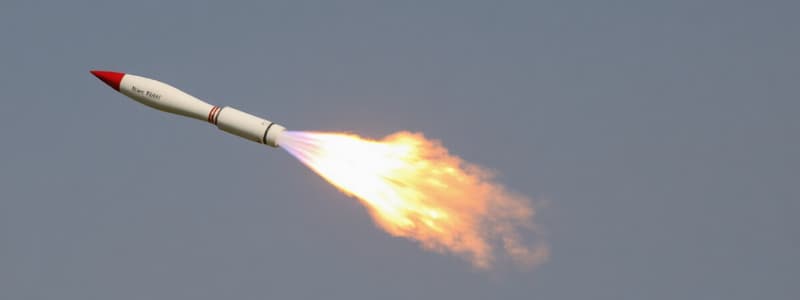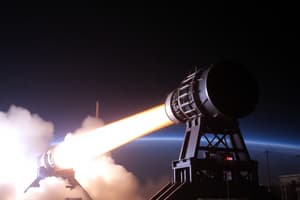Podcast
Questions and Answers
What record did Aftershock II break?
What record did Aftershock II break?
- Maximum weight of an amateur rocket
- Highest altitude achieved by an amateur rocket (correct)
- First rocket built by students to reach space
- Highest speed of an amateur rocket
How long did it take Aftershock II to reach its peak altitude?
How long did it take Aftershock II to reach its peak altitude?
- 19 seconds
- 60 seconds
- 92 seconds (correct)
- 85 seconds
Which technological advancements contributed to the success of Aftershock II?
Which technological advancements contributed to the success of Aftershock II?
- Reinforced structure and advanced navigation systems
- Titanium-coated fins and heat-resistant paint (correct)
- Hybrid propulsion system and lightweight materials
- Autopilot features and enhanced fuel efficiency
What is the Kármán line, as mentioned in relation to RPL's achievements?
What is the Kármán line, as mentioned in relation to RPL's achievements?
What was Aftershock II's maximum speed shortly after launch?
What was Aftershock II's maximum speed shortly after launch?
What is the primary focus of RPL's future projects?
What is the primary focus of RPL's future projects?
Approximately how many people are part of the RPL team?
Approximately how many people are part of the RPL team?
What happened to Aftershock II's engine after launch?
What happened to Aftershock II's engine after launch?
Flashcards
Kármán line
Kármán line
The point in the Earth's atmosphere where space is considered to begin.
Sounding rocket
Sounding rocket
A rocket designed to carry instruments into space for scientific research.
USC Rocket Propulsion Lab (RPL)
USC Rocket Propulsion Lab (RPL)
The USC Rocket Propulsion Lab (RPL) is a student-led organization dedicated to designing, building, and launching rockets. They broke the world record in 2024 with their Aftershock II rocket.
Aftershock II
Aftershock II
Signup and view all the flashcards
GoFast rocket
GoFast rocket
Signup and view all the flashcards
What is the Kármán line?
What is the Kármán line?
Signup and view all the flashcards
Speed of Aftershock II
Speed of Aftershock II
Signup and view all the flashcards
Aftershock II's innovations
Aftershock II's innovations
Signup and view all the flashcards
Study Notes
USC Rocket Propulsion Lab Achievement
- USC Rocket Propulsion Lab (RPL) students launched "Aftershock II," surpassing a 20-year record for amateur rockets.
- Aftershock II reached an altitude of 470,000 feet (143.3 km).
- This is 90,000 feet (27.4 km) higher than the previous record set by "GoFast" in 2004 (380,000 feet/115.8 km).
- The 14-foot (4 m) tall rocket broke the sound barrier within 2 seconds of launch.
Rocket Performance Details
- Aftershock II reached a maximum speed of 3,600 mph (5,800 km/h) - 5.5 times the speed of sound - within 19 seconds.
- This slightly exceeded the 2004 speed record.
- Engine burned out shortly after launch, but the rocket continued ascending.
- It left Earth's atmosphere about 85 seconds after launch and reached its peak altitude in 92 seconds.
- The rocket's nose cone detached, deploying a parachute for a safe landing.
Technological Innovations
- Titanium-coated fins and a new heat-resistant paint allowed the rocket to withstand high-speed temperatures.
- Student-designed computer systems tracked the rocket's position in real-time and transmitted live data.
Impact and Future Goals
- The student team successfully launched the rocket to a new record height.
- The RPL team also broke another milestone in 2019, achieving the first student-built rocket to cross the Kármán line (100 km).
- The next goal is for the RPL to focus on sounding rockets which carry scientific instruments for research purposes, instead of exceeding altitude records.
- 470,000 feet is close to the amateur rocketry limit of 490,000 feet.
- Special clearances are required for exceeding that limit.
Studying That Suits You
Use AI to generate personalized quizzes and flashcards to suit your learning preferences.




